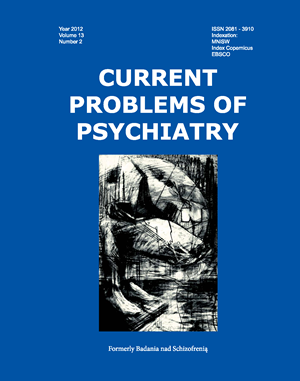Coping with stress and evaluation of the quality of life in patients with a knee joint injury
Keywords:
knee instability, anterior cruciate ligament, meniscus injury, functional knee insufficiency, anterior knee pain, patellofemoral disorders, coping with stressAbstract
The aim of the study was to answer the following research questions:
- whether and what kind of relations occur between stress coping methods, on the one hand, and evaluation of quality of life and the degree of activity limitation with regard to work and social relations, on the other, in patients with a knee joint injury;
- whether and what differences occur with regard to stress-coping methods in patients with knee-joint disorders vs. healthy persons.
In the study, an attempt was also made to identify those stress-coping methods which are the best predictors of the patients’ evaluation of quality of life and the degree of limitation of work-related activity and social relations in patients with a knee-joint injury.
Participants. The participants were 32 in-patients (15 women and 17 men) of ARTHROS Non-Public Health Care Institution in Nałęczów, hospitalized for a knee joint injury. Mean age of the participants was 31 years. Seventeen patients had been diagnosed with knee instability due to cruciate ligament injury, 3 with the excessive lateral pressure syndrome, 2 with luxating patella, 8 with meniscus injury, and 1 with intraarticular knee fracture. Mean disease duration was about 5 years. Preoperative treatment in the form of rehabilitation and physiotherapy had been given to 7 persons.
Methods. The study was performed using the Coping with Stress Questionnaire adapted into Polish by Januszewska [6] and a self-designed Inquiry Form for collecting socio-demographic data plus information on disease duration and patients’ evaluation of the effect of the disease on quality of life, professional work, social relations, and hobbies. The patients filled in the above-mentioned questionnaires within the first two days after operation.
Results and conclusions:
The more often the patients use ineffective methods of coping with stress, the greater are the negative changes in their quality of life and the disease-related limitations that they experience on the professional plane as well as with regard to their social, relations and hobbies.
The sense of the radical changes brought about by the disease in the patients’ lives co-occurs with their concentration on the experienced difficulties, constant recalling of them, and the defence mechanism used in a situation of stress, i.e. rationalization and denial.
The sense of radical limitation by the disease of work-related activities is connected with responding to stress which involves recollecting the experienced suffering and problems.
The sense of radical limitation by the disease of contacts with acquaintances co-occurs with responses to stress which involve abuse of alcohol and tranquilizers, a sense of dejection and hopelessness, pessimism, and looking outside of oneself for causes and sources of the difficulties connected with the unpleasant experience.
The sense of the radical, disease-related deterioration of quality of life is connected with responding to stress which involves focusing on the experienced suffering and frequent recollecting of the difficulties one is going through.
The sense that the disease has restricted one’s hobby is associated with responding to stress by suppressing emotions and blaming oneself for the current difficulties.
References
1. Folkman S., Lazarus R.S. If it changes it must be a process: study of emotion and coping during three stages of a college examination. J. Pers. Soc. Psychol., 1985; 48(1): 150-170.
2. Lazarus R.S. Coping theory and research: past, present, and future. Psychosom. Med., 1993; 55(3): 234-247.
3. Lazarus R.S., Folkman S. Stress, appraisal, and coping. New York; Springer: 1984.
4. Sęk. H. Wybrane zagadnienia z psychoprofilaktyki. W: Sęk H. red., Społeczna psychologia kliniczna. Warszawa; PWN: 1993, s. 472-502.
5. Oleś P. Z problematyki interwencji kryzysowej i radzenia sobie ze stresem. W: Januszewski A., Oleś P., Otrębski W. red., Studia z Psychologii w Katolickim Uniwersytecie Lubelskim. T. 8, Redakcja Wydawnictw KUL; Lublin: 1996, s. 249-265.
6. Januszewska E. Kwestionariusz Radzenia sobie ze stresem. Wartość diagnostyczna i wyniki badań młodzieży. W: Oleś P. red., Wybrane zagadnienia z psychologii klinicznej i osobowości. Metody diagnostyczne w badaniach dzieci i młodzieży. Towarzystwo Naukowe KUL; Lublin: 2005, s. 91-124.
7. Heszen-Niejodek I. Teoria stresu psychologicznego i radzenia sobie. W: Strelau J. red., Psychologia. Podręcznik akademicki. T.3. GWP; Gdańsk: 2000, s. 465-492.
8. Heszen-Niejodek I. Styl radzenia sobie ze stresem jako indywidualna zmienna wpływająca na funkcjonowanie w sytuacji stresowej. W: Strelau J. red., Osobowość a ekstremalny stres. GWP, Gdańsk, 2004, s. 238-263.
9. Jarosz M. (red.), Psychologia lekarska. PZWL; Warszawa: 1983.
10. Lipowski Z.J. Psychosomatic medicine today. Psychiatr. Pol., 1975; 4: 377-388.
11. Rosenberger P., Ickovics J., Epel E., D’Entremont D., Jokl P. Physical recovery in arthroscopic knee surgery unique contributions of coping behaviors to clinical outcomes and stress reactivity. Psychol. Health, 2004; 19(3): 307-320.
12. Stephens M.A.P., Zautra A.J., Druley J.A. Older adults’ recovery from surgery for osteoarthritis of the knee: psychosocial resources and constraints as predictors of outcomes. Health Psychol., 2002; 21(4): 377-383.
13. Udry E. Coping and social support among injured athletes following surgery. J. Sport Exer. Psychol., 1997; 19: 71-90.
14. Thomeé P., Währborg P., Börjesson M., Thomeé R., Eriksson B.I., Karlsson J. A new instrument for measuring self-efficacy in patients with an anterior cruciate ligament injury. Scand. J. Med. Sci. Sports, 2006; 16: 181-187.
15. Nyland J., Johnson D.L., Caborn D.N., Brindle T. Internal health status belief and lower perceived functional deficit are related among anterior cruciate ligament-deficient patients. Arthroscopy, 2002; 18: 515-518.
16. Johnson U. Coping strategies among long-term injured competitive athletes. A study of 81 men and women in team and individual sports. Scand. J. Med. Sci. Sports, 1997; 7: 367-372.


